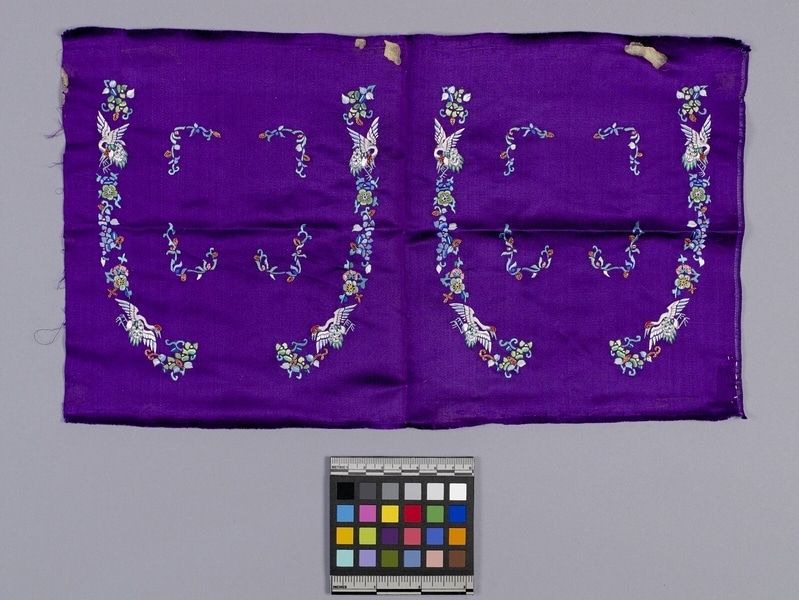Pillow End Panel Item Number: N3.26 from the MOA: University of British Columbia


Description
A pair of embroidered panels on a horizontal rectangle of purple silk. Each panel is finely embroidered with an arch shape open at the top made up of flowers, leaves, and four white cranes with red heads in flight, one of which is near the bottom while the other is near the top of the side of the arch shape. The flowers are predominantly in shades of blue and green. Some details are couched in gold thread. Within the arch are four wide v-shapes of embroidered flowers and leaves opening toward the centre of the panel.
History Of Use
Such panels formed the sides of high pillows, square or rounded in cross-section, used to keep cool and to preserve the user’s hairdo. The pillows were filled with grain, such as unhusked rice. Such special pillow ends were used by wealthy people and members of the official “yangban” class. Such work was done by women working in workshops. Other pillow end panels from the same collection include N3.26, N3.32, and N3.33.
Specific Techniques
Embroidery pattern on coloured paper was transferred onto the silk using fine needles. The specific forms were done by eye, not following a detailed pattern. The embroidery was done with the silk cloth stretched on a rectangular frame. The satin was probably machine-made and the dye is synthetic.
Iconographic Meaning
The materials and fine work indicate that this was intended for use by a high-class person. The dark colour indicates that it was for use by a man or an older woman. The cranes symbolize intelligence and purity.
Item History
- Made in Korea before 1939
- Collected between 1899 and 1939
- Owned by Marion Stephan before August 1964
- Received from Marion Stephan (Donor) during August 1964
What
- Name
- Pillow End Panel
- Identification Number
- N3.26
- Type of Item
- panel
- Material
- silk fibre, dye, gold metal, paste adhesive and paper
- Manufacturing Technique
- woven, dyed, transferred, embroidered, couched and pasted
- Overall
- height 22.3 cm, width 38.6 cm, depth 0.2 cm
Who
- Culture
- Korean
- Previous Owner
- Marion Stephan
- Received from
- Marion Stephan (Donor)
Where
- Holding Institution
- MOA: University of British Columbia
- Made in
- Korea
When
- Creation Date
- before 1939
- Collection Date
- between 1899 and 1939
- Ownership Date
- before August 1964
- Acquisition Date
- during August 1964
Other
- Item Classes
- textiles
- Condition
- good
- Accession Number
- 0113/0057 k